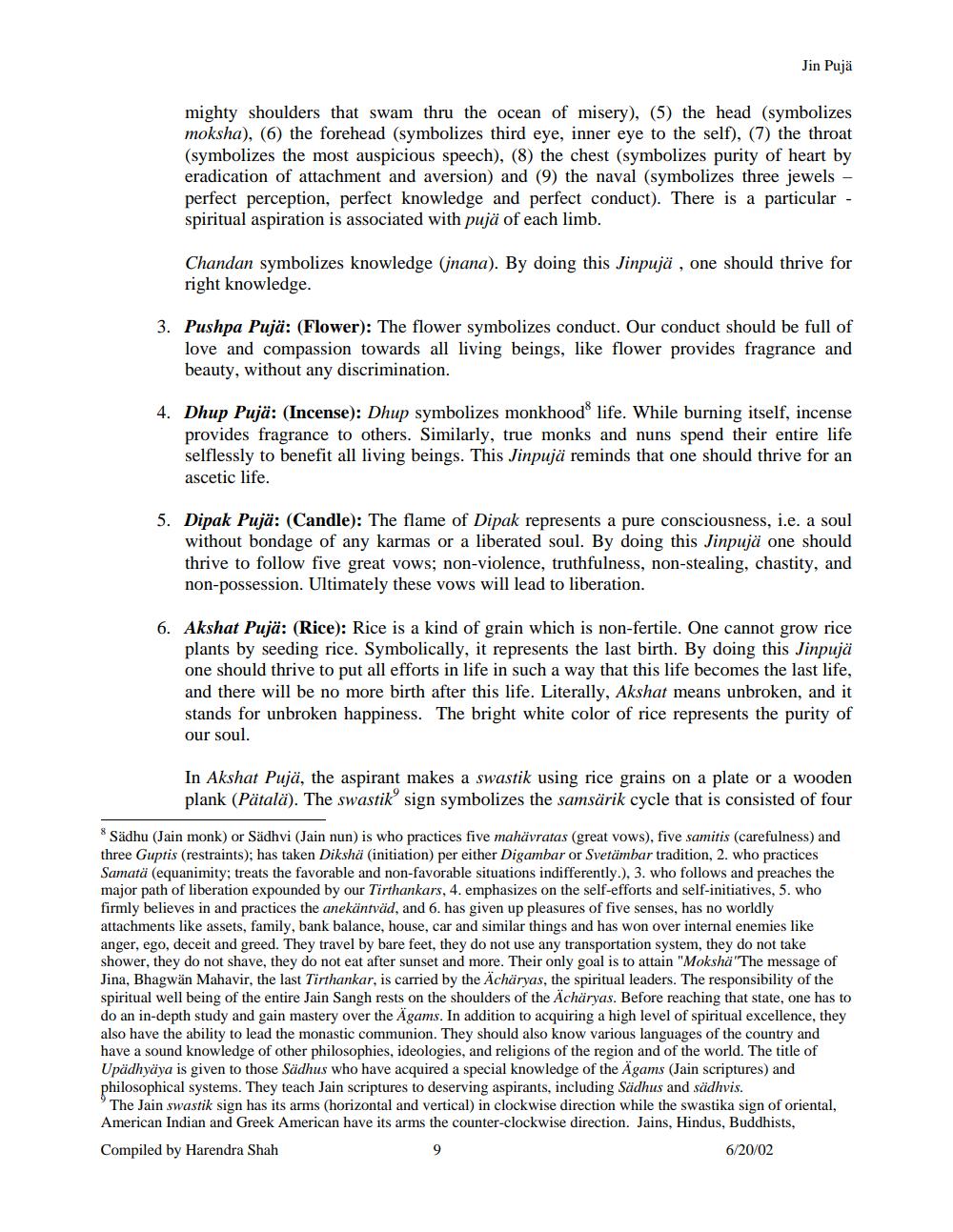Book Title: Jin puja Author(s): Harendra Shah Publisher: USA Jain Center Northern Calfornia View full book textPage 9
________________ Jin Pujä mighty shoulders that swam thru the ocean of misery), (5) the head (symbolizes moksha), (6) the forehead (symbolizes third eye, inner eye to the self), (7) the throat (symbolizes the most auspicious speech), (8) the chest (symbolizes purity of heart by eradication of attachment and aversion) and (9) the naval (symbolizes three jewels - perfect perception, perfect knowledge and perfect conduct). There is a particular - spiritual aspiration is associated with pujä of each limb. Chandan symbolizes knowledge (jnana). By doing this Jinpujä, one should thrive for right knowledge. 3. Pushpa Pujä: (Flower): The flower symbolizes conduct. Our conduct should be full of love and compassion towards all living beings, like flower provides fragrance and beauty, without any discrimination. 4. Dhup Pujä: (Incense): Dhup symbolizes monkhood life. While burning itself, incense provides fragrance to others. Similarly, true monks and nuns spend their entire life selflessly to benefit all living beings. This Jinpujä reminds that one should thrive for an ascetic life. 5. Dipak Pujä: (Candle): The flame of Dipak represents a pure consciousness, i.e. a soul without bondage of any karmas or a liberated soul. By doing this Jinpujä one should thrive to follow five great vows; non-violence, truthfulness, non-stealing, chastity, and non-possession. Ultimately these vows will lead to liberation. 6. Akshat Pujä: (Rice): Rice is a kind of grain which is non-fertile. One cannot grow rice plants by seeding rice. Symbolically, it represents the last birth. By doing this Jinpujä one should thrive to put all efforts in life in such a way that this life becomes the last life, and there will be no more birth after this life. Literally, Akshat means unbroken, and it stands for unbroken happiness. The bright white color of rice represents the purity of our soul. In Akshat Pujä, the aspirant makes a swastik using rice grains on a plate or a wooden plank (Pätalä). The swastik sign symbolizes the samsärik cycle that is consisted of four Sädhu (Jain monk) or Sädhvi (Jain nun) is who practices five mahävratas (great vows), five samitis (carefulness) and three Guptis (restraints); has taken Dikshä (initiation) per either Digambar or Svetämbar tradition, 2. who practices Samatä (equanimity; treats the favorable and non-favorable situations indifferently.), 3. who follows and preaches the major path of liberation expounded by our Tirthankars, 4. emphasizes on the self-efforts and self-initiatives, 5. who firmly believes in and practices the anekäntväd, and 6. has given up pleasures of five senses, has no worldly attachments like assets, family, bank balance, house, car and similar things and has won over internal enemies like anger, ego, deceit and greed. They travel by bare feet, they do not use any transportation system, they do not take shower, they do not shave, they do not eat after sunset and more. Their only goal is to attain "Mokshä"The message of Jina, Bhagwan Mahavir, the last Tirthankar, is carried by the Acharyas, the spiritual leaders. The responsibility of the spiritual well being of the entire Jain Sangh rests on the shoulders of the Achäryas. Before reaching that state, one has to do an in-depth study and gain mastery over the Agams. In addition to acquiring a high level of spiritual excellence, they also have the ability to lead the monastic communion. They should also know various languages of the country and have a sound knowledge of other philosophies, ideologies, and religions of the region and of the world. The title of Upädhyaya is given to those Sädhus who have acquired a special knowledge of the Agams (Jain scriptures) and philosophical systems. They teach Jain scriptures to deserving aspirants, including Sädhus and sädhvis. The Jain swastik sign has its arms (horizontal and vertical) in clockwise direction while the swastika sign of oriental, American Indian and Greek American have its arms the counter-clockwise direction. Jains, Hindus, Buddhists, Compiled by Harendra Shah 6/20/02Page Navigation
1 ... 7 8 9 10 11 12 13 14 15 16
